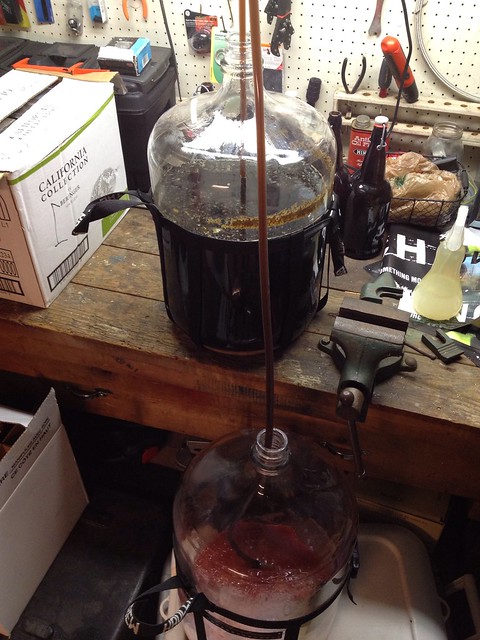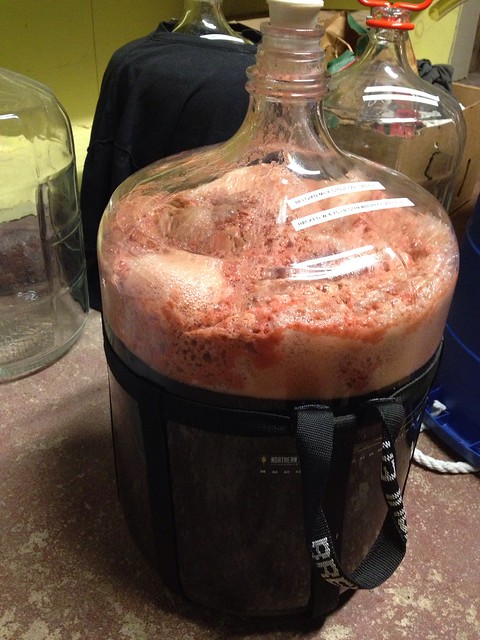Strawberry Belgian Milk Stout, Part 2: Secondary Fermentation and Kegging
In my previous post about this beer, I included the recipe but left out the part where I add the strawberries. The primary fermentation was mostly finished after just a few days but I let it sit for 9 days to let the yeast and whatnot to settle out some more. Before racking it to a secondary fermentor, I pureed about 4.75 lbs of strawberries and then pasteurized the puree by heating it to 160° F and holding it there for 10 minutes. Some people advise against doing this as it can do something to the pectins in the fruit and then you end up with a really cloudy beer. Since this is a stout, I don’t think cloudiness is really an issue. And even if it was, I don’t really care. The last time I tried to use strawberries in a beer I ended up getting some kind of weird infection or wild yeast or something that made it taste like burnt rubber. Hopefully this time the pasteurization will prevent anything like that from happening.
After letting the strawberry puree cool down to around room temperature, I dumped it all in an empty (and sanitized) 6.5 gallon carboy. Normally I would use a 5 gallon for secondary, but this batch ended up being more like 5.5 gallons, so with the addition of almost 5 lbs of fruit, I figured I needed a little more room.

Adding strawberry puree to the 6.5 gallon carboy

4.75 lbs of strawberry puree in a 6.5 gallon carboy
I then racked the beer on top of the fruit.

Well, that was the plan, anyway. What really happened was I racked the beer underneath a thick layer of strawberry puree. I thought about pulling the hose up a bit and forcing it to cover the fruit, but in order to minimize any exposure to oxygen I just let it go. I was a little worried the fruit would just sit on top and prevent any real flavor from coming through but I figured I could deal with that if it happened. Also, because there was so much extra head space in the 6.5 gallon carboy, I topped it off with a layer of CO2, just be sure. If you have a kegging set up, this is as simple as putting one of your gas lines in and opening it up for a few seconds. Since CO2 is heaver than air it will push all the existing air out the top and leave you with a blanket of CO2. If you don’t have a kegging setup, I’m not sure of a practical way of doing this.

Belgian Milk Stout sitting under 4.75 lbs of strawberry puree
With all the natural sugars that are in the puree, I knew the yeast still in the beer would wake up and I would see some more activity, which would hopfully cause the fruit to start settling down into the beer.
The next day, there was definitely evidence of some more activity.

A few days later, things settled back down, and after about a week it looked like a lot of the fruit had finally sunk down into the beer. Since this is a relatively low gravity beer, I decided to move it into the keg on 7/6, about 17 days after racking to secondary. If this was a bigger beer I probably would have waited a month or two.
The sample I took a few days before definitely had some noticeable strawberry flavor but it was pretty subtle. With the strong flavors of the dark malts and the Belgian yeast it seemed like it could be getting lost in the mix. To try and get just a little more strawberry flavor on top I decided to add about 375ml of Adult Strawberry Milk.

That may turn out to have been a bad idea. Or it could be exactly what this beer needed. Or it could end up making no difference at all. Or I might find that it helped a little bit and that maybe I should even add some more. There’s actually a lot of different ways this could go.
It’s been carbonating less than 24 hours (at 30 psi) so it’s really foamy but still a little flat, but I think it actually tastes pretty good so far. The first pour had a ton of sediment in it. I didn’t strain the puree so there’s probably still seeds and stuff in there but most of that should settle out and come out with the next couple pours. I’ll post a more thorough review when it’s fully carbonated.